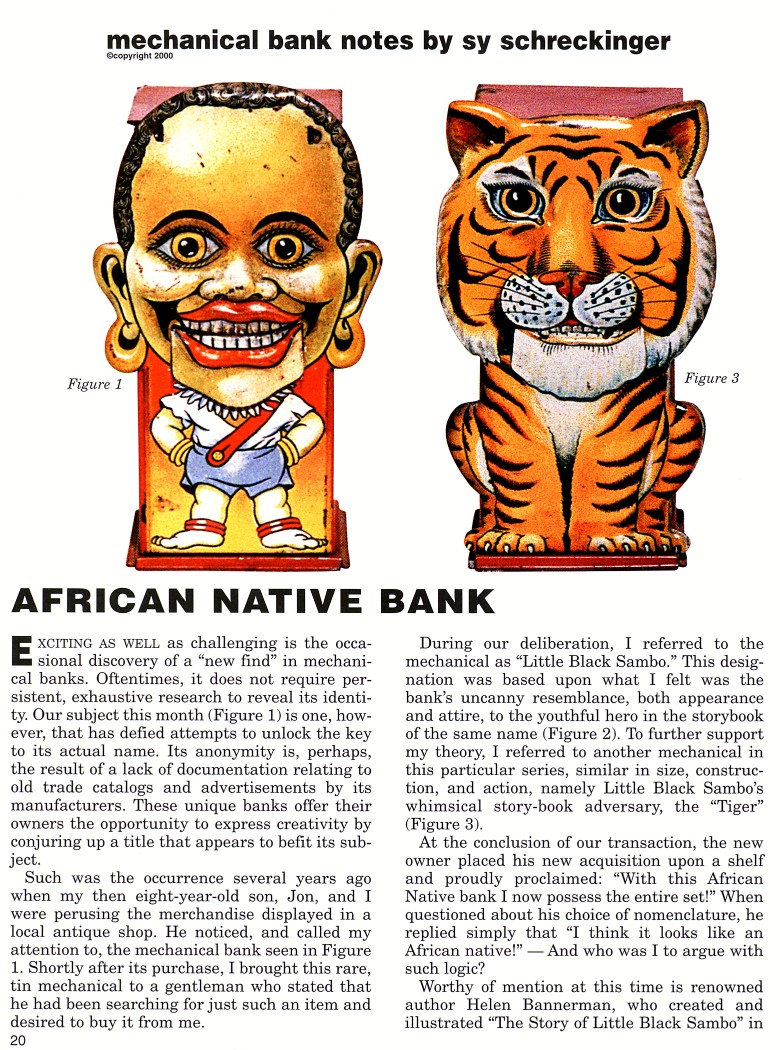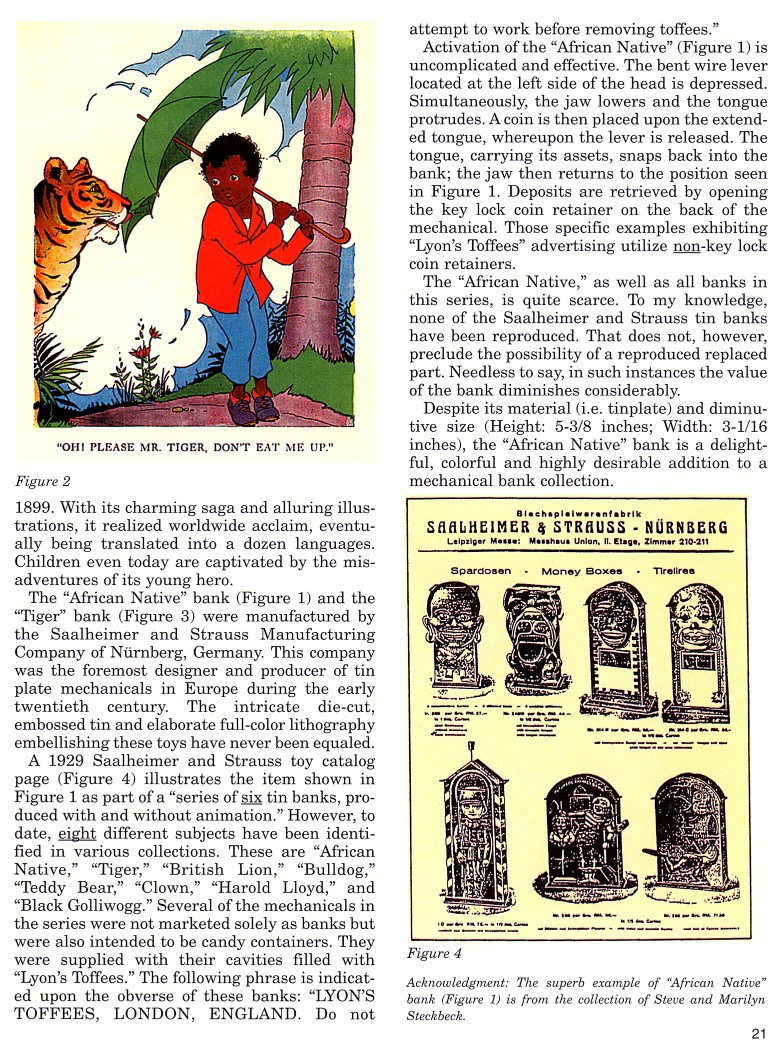|
African Native Bank
by Sy Schreckinger – ANTIQUE TOY WORLD Magazine – September,
2000
Exciting as well as challenging is the
occasional discovery of a "new find" in mechanical banks. Oftentimes, it
does not require persistent, exhaustive research to reveal its identity.
Our subject this month (Figure 1) is one, however, that has defied
attempts to unlock the key to its actual name. Its anonymity is, perhaps,
the result of a lack of documentation relating to old trade catalogs and
advertisements by its manufacturers. These unique banks offer their owners
the opportunity to express creativity by conjuring up a title that appears
to befit its subject.
Such was the occurrence several years ago when my then eight-year-old
son, Jon, and I were perusing the merchandise displayed in a local antique
shop. He noticed, and called my attention to, the mechanical bank seen in
Figure 1. Shortly after its purchase, I brought this rare, tin mechanical
to a gentleman who stated that he had been searching for just such an item
and desired to buy it from me.
During our deliberation, I referred to the mechanical as "Little
Black Sambo." This designation was based upon what I felt was the bank's
uncanny resemblance, both appearance and attire, to the youthful hero in
the storybook of the same name (Figure 2). To further support my theory, I
referred to another mechanical in this particular series, similar in size,
construction, and action, namely Little Black Sambo's whimsical story-book
adversary, the "Tiger" (Figure 3).
At the conclusion of our transaction, the new owner placed his new
acquisition upon a shelf and proudly proclaimed: "With this African Native
bank I now possess the entire set!" When questioned about his choice of
nomenclature, he replied simply that "I think it looks like an African
native!" — And who was I to argue with such logic?
Worthy of mention at this time is renowned author Helen Bannerman,
who created and illustrated "The Story of Little Black Sambo" in 1899.
With its charming saga and alluring illustrations, it realized worldwide
acclaim, eventually being translated into a dozen languages. Children even
today are captivated by the misadventures of its young hero.
The "African Native" bank (Figure 1) and the "Tiger" bank (Figure 3)
were manufactured by the Saalheimer and Strauss Manufacturing Company of
Nurnberg, Germany. This company was the foremost designer and producer of
tin plate mechanicals in Europe during the early twentieth century. The
intricate die-cut, embossed tin and elaborate full-color lithography
embellishing these toys have never been equaled.
A 1929 Saalheimer and Strauss toy catalog page (Figure 4) illustrates
the item shown in Figure 1 as part of a "series of six tin banks, produced
with and without animation." However, to date, eight different subjects
have been identified in various collections. These are "African Native,"
"Tiger," "British Lion," "Bulldog," "Teddy Bear," "Clown," "Harold Lloyd,"
and "Black Golliwogg." Several of the mechanicals in the series were not
marketed solely as banks but were also intended to be candy containers.
They were supplied with their cavities filled with "Lyon's Toffees." The
following phrase is indicated upon the obverse of these banks: "LYON'S
TOFFEES, LONDON, ENGLAND. Do not attempt to work before removing toffees."
Activation of the "African Native" (Figure 1) is uncomplicated and
effective. The bent wire lever located at the left side of the head is
depressed. Simultaneously, the jaw lowers and the tongue protrudes. A coin
is then placed upon the extended tongue, whereupon the lever is released.
The tongue, carrying its assets, snaps back into the bank; the jaw then
returns to the position seen in Figure 1. Deposits are retrieved by
opening the key lock coin retainer on the back of the mechanical. Those
specific examples exhibiting "Lyon's Toffees" advertising utilize non-key
lock coin retainers.
The "African Native," as well as all banks in this series, is quite
scarce. To my knowledge, none of the Saalheimer and Strauss tin banks have
been reproduced. That does not, however, preclude the possibility of a
reproduced replaced part. Needless to say, in such instances the value of
the bank diminishes considerably.
Despite its material (i.e. tinplate) and diminutive
size (Height: 5-3/8 inches; Width: 3-1/16 inches), the "African Native"
bank is a delightful, colorful and highly desirable addition to a
mechanical bank collection.
Acknowledgment: The superb example of "African Native" bank (Figure
1) is from the collection of Steve and Marilyn Steckbeck.
|


